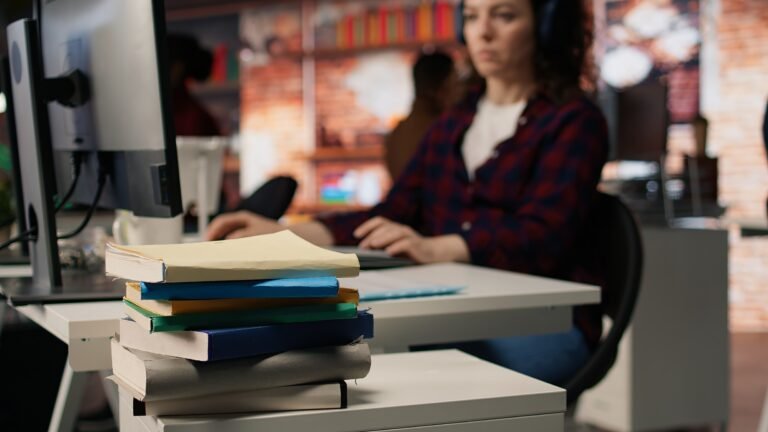An author sits at their screen, watching as five polished book covers appear in seconds. Each one looks professional, market-ready, and perfectly aligned with the story’s genre. No long emails, no waiting weeks for revisions, just a few typed prompts and instant results.
It feels like magic, but it also raises a quiet unease. Is this still art, or just efficient imitation? The act of designing a book cover has shifted from a deeply creative exchange to a quick collaboration with code.
As AI tools take over more of what once required intuition and experience, the line between creativity and convenience begins to blur. The future of book front cover design may not belong entirely to machines or artists. Instead, it might rest somewhere in between, a place where technology serves imagination, not replaces it.
A Quick Look Back – From Paintbrush to Pixel
Before algorithms and prompts, artists spent weeks painting book covers by hand. Every brushstroke carried intention, often guided by the author’s vision and the mood of the story. Then came the digital revolution. Tools like Photoshop and Illustrator changed how designers worked, making it easier to experiment with color, texture, and typography.
Now, another transformation is here. Artificial intelligence has entered the creative process, producing full book front cover designs in seconds. It’s the next leap, faster and more accessible than ever. But this shift also signals a question for authors and designers: in a world where machines can design a book cover instantly, what happens to the human touch that once defined it?
The Promise of AI – Fast, Flashy, and Fascinating
Artificial intelligence tools like Midjourney, Leonardo, DALL·E, and Firefly are changing how visuals come to life. With a few descriptive prompts, an author can see multiple book front cover design options before their coffee cools. These systems pull from vast data sets, recognizing artistic styles, lighting, and mood cues to create stunning results.
For self-publishers, this is a dream come true. AI saves time and money, producing eye-catching designs without the long back-and-forth typical of book cover design services. It offers near-endless variations, quick revisions, and visual consistency across series.
Yet, beneath the shine lies something missing. These covers often feel perfect but hollow, beautiful yet disconnected. Technology can mimic style, but it cannot feel story. And without that emotional thread, the art risks becoming decoration instead of communication.
The Human Element – Design Beyond Data
A skilled designer reads between the lines of a manuscript. They sense tone, emotion, and symbolism in ways a machine cannot. When they design a book cover, they translate words into mood, texture, and meaning. A color choice might capture heartbreak. A font might whisper mystery. Their work reflects not just skill but empathy.
Human creativity carries imperfections that make art memorable. Designers interpret subtext, cultural nuance, and emotion. They notice how a story feels, not just how it looks. AI can generate a striking image, but it lacks intuition—the quiet awareness that connects image to soul.
In the end, great book cover design services do more than decorate a story. They listen to it, understand it, and give it a visual identity that feels alive.
Case Study
Last year, an indie author tested both sides of creativity. They used an AI tool to design a book cover for their mystery novel, then hired a professional designer to create another version. The AI cover was sleek and dramatic, filled with all the right visual cues like fog, shadows, and bold fonts. It looked like every best-seller in the genre.
The human designer, on the other hand, asked questions about the story’s heart. The final book front cover design was quieter but more personal, showing a single object from the plot that hinted at the book’s emotional core. Readers noticed.
The AI version got quick attention online, but the human version sparked conversation and curiosity. It reminded the author that a powerful cover does more than grab the eye. It connects to the reader’s feelings.
The Darker Side – When Algorithms Outshine Artists
The rise of AI-generated art has created an uncomfortable tension in creative industries. Many of these systems learn by studying millions of existing images, including works made by real artists. That means AI tools can unknowingly borrow from copyrighted material, turning someone’s original style into a pattern in its data.
This raises difficult questions about ownership and fairness. As more authors turn to automated book cover design services, independent artists find fewer opportunities to showcase their talent. Visual trends start blending together, creating covers that look polished but strangely familiar.
For many designers, the shift feels deeply personal. Years of skill, study, and storytelling are being reduced to algorithms trained to copy beauty. The fear is not just about losing work. It is about losing meaning. If stories are born from human emotion, their covers should reflect the same.
The Collaboration Path – Humans + AI, Not Humans vs. AI
The smartest creators are no longer choosing sides. They use AI as a creative partner, not a replacement. A designer might start by generating concept sketches through AI, exploring colors, layouts, or lighting ideas in minutes. From there, human skill takes over, refining the details that give the image emotion and depth.
This hybrid workflow saves time while keeping the heart of design intact. For authors, it means faster results with more creative range. For designers, it opens new ways to experiment and innovate within book cover design services. When machines assist and humans interpret, designing a book cover becomes a richer process, blending precision with personality. Collaboration turns technology into a tool of imagination, not imitation.
The Future of Book Design – The Beauty and the Bias
The next chapter of book front cover design is already unfolding. AI-assisted design studios are emerging, using algorithms trained on licensed data to ensure ethical use of art. Transparency is becoming essential, with more creators openly labeling AI involvement in their projects.
Yet challenges remain. Bias in AI data can shape how characters, settings, and even emotions appear on covers, often reinforcing stereotypes. Future designers must pair technology with awareness, using it thoughtfully and responsibly. The future of book cover design services will depend on balance and creative freedom guided by ethics.
Conclusion – The Real Cover Story
Artificial intelligence can make an image, but only people can make meaning. The best covers are not just attractive; they carry soul, emotion, and story. As AI becomes part of the creative process, the goal is not to erase the human hand but to enhance it.
In the end, a great book front cover design speaks to readers before they even open the first page. It bridges story and emotion, technology and heart. When AI designs your book cover, it gives you an image. When a human does, it gives your story a face.










